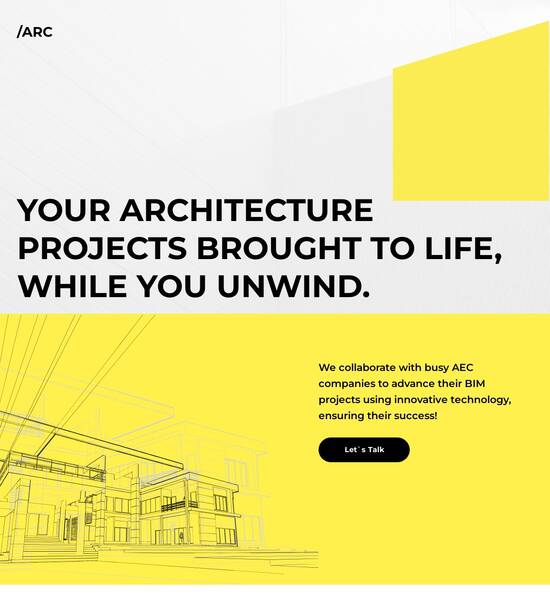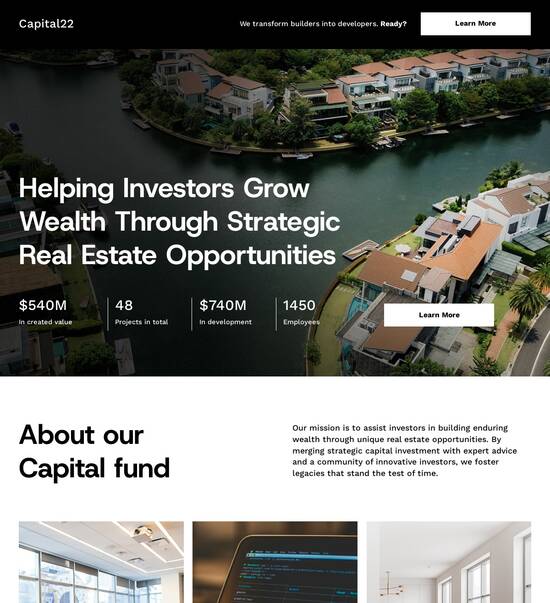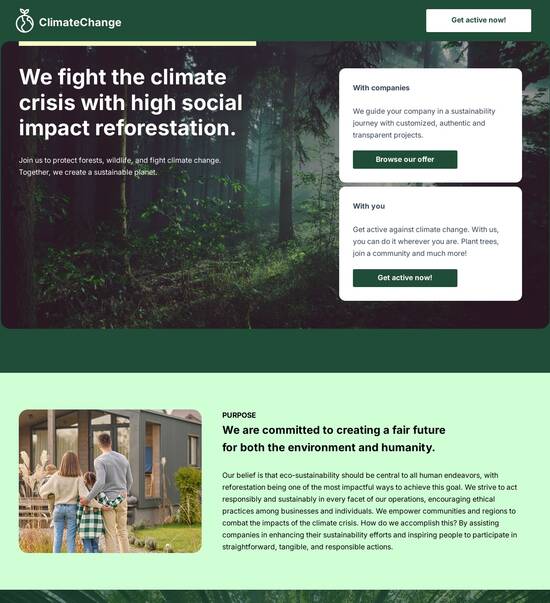
Web page template for home automation companies
Use TemplateAbout template
Give your home automation companies a boost with our professional landing page templates. Ready to turn visitors into customers?
Recommended templates

Easy to build without coding
With the intuitive drag-and-drop builder, anyone on your team can create high-converting pages without any knowledge of code or design. Make enhancements to your landing page with custom widgets using Javascript, HTML/CSS, or third-party scripts.

Multiple layouts for any industry and goal
Select from 500+ landing page layouts built to boost conversions across industry-specific scenarios. Customize them by adjusting fonts, adding images, and generating on-brand content with the AI assistant. Quickly scale with Instablocks® and Global Blocks that you can save, reuse, and update globally.

Loads fast and looks polished on any device
Every template is responsive, which means they present professionally on any device and load blazingly fast with our Thor Render Engine. You can also power them up with Google AMP technology to deliver an unparalleled mobile experience and drive higher conversions.

Robust analytics & experimentation
Get real-time updates and reporting across all your devices, showing the number of visitors, conversions, cost-per-visitor, and cost-per-lead. Launch AI-powered experiments, run A/B tests, and use heatmaps to analyze user behavior, then optimize your landing page to maximize conversions.







Easy to build without coding
With the intuitive drag-and-drop builder, anyone on your team can create high-converting pages without any knowledge of code or design. Make enhancements to your landing page with custom widgets using Javascript, HTML/CSS, or third-party scripts.
Multiple layouts for any industry and goal
Select from 500+ landing page layouts built to boost conversions across industry-specific scenarios. Customize them by adjusting fonts, adding images, and generating on-brand content with the AI assistant. Quickly scale with Instablocks® and Global Blocks that you can save, reuse, and update globally.
Loads fast and looks polished on any device
Every template is responsive, which means they present professionally on any device and load blazingly fast with our Thor Render Engine.
Robust analytics & experimentation
Get real-time updates and reporting across all your devices, showing the number of visitors, conversions, cost-per-visitor, and cost-per-lead. Launch AI-powered experiments, run A/B tests, and use heatmaps to analyze user behavior, then optimize your landing page to maximize conversions.
All the features you need to build smart home website template
Explore more featuresLearn how to build template based automation system
Frequently asked questions about smart home automation website template
Leading the way in building high-performing landing pages





Smart home website template free: Your ultimate how-to guide
Instapage serves as an essential tool for marketers looking to enhance their digital campaigns with landing page optimization. With its extensive features, Instapage ensures that your marketing efforts yield maximum ROI. This guide will walk you through the steps involved in leveraging Instapage to its fullest, tailored specifically for those in marketing and advertising, particularly in industries like tech, education, and financial services.
Understanding the role of landing page optimization
Landing page optimization is crucial for converting visitors into leads. By ensuring your landing pages are designed with conversion in mind, you can significantly improve the performance of your marketing campaigns. Instapage offers a variety of features that cater to the unique needs of different industries, making it an invaluable asset for many businesses.
- High-converting templates: Instapage provides a library of over 100 templates designed to encourage conversions, allowing marketers to launch campaigns without the hassle of building from scratch.
- Personalization capabilities: With tools for dynamic text replacement, marketers can create tailored experiences for different audience segments, enhancing user experience and engagement.
- A/B testing options: The built-in experimentation features allow you to test various elements at ease, ensuring that each page variant is optimized for the best performance.
Step 1: Selecting the right template for your needs
Choosing an appropriate template is essential to streamline your landing page design. Instapage’s library includes numerous customizable layouts aimed at various audiences. Follow these steps for selection:
- Identify your audience: Understanding who your main users are allows you to filter templates that resonate best with their needs.
- Consider your campaign goals: Are you focused on lead generation or sales? This will impact your template choice as different templates serve different objectives.
- Test variations: Utilize A/B testing to measure the effectiveness of selected templates and iterate based on performance data.
Step 2: Optimizing for conversions
Beyond just choosing a template, optimizing every element on your landing page is crucial. Consider implementing the following strategies:
- Utilize compelling CTAs: Calls-to-action should be clear, concise, and lead users toward desired actions, such as signing up or making purchases.
- Incorporate engaging visuals: Images, videos, and graphics can aid in stressing your key messages and holding visitor attention.
- Analyze user behavior: Instapage provides heatmaps that display how users interact with your page, enabling data-driven enhancements.
Step 3: Personalizing the user experience
Creating a unique experience for each user segment can drastically improve conversion rates. Consider these personalization tactics:
- Customize messaging: Use dynamic text replacement to adjust headlines and content based on the user's source or previous interactions.
- Align your ads: Use AdMaps to match your landing pages with existing ads, ensuring continuity in messaging throughout the customer journey.
- Segment tracking: With Instapage’s analytics tools, monitor individual audience performance to refine your strategies continuously.
Using Instapage as your landing page and CRO platform equips you to create high-performance marketing campaigns that are both effective and easy to manage.
Get started today with Instapage and transform your landing page experience, ensuring every campaign drives the results you aim for! Sign up now!
People also ask about home automation website design
Web page templates for home automation companies: Building your online presence
The importance of web presence for home automation companies
A strong online presence is essential for home automation companies today as consumers increasingly rely on digital channels to discover and purchase smart products. The home automation sector has experienced remarkable growth, driven by advancements in technology, increased consumer spending on connected devices, and a shift towards more automated lifestyles. As a result, businesses in this space must establish a compelling digital footprint to engage potential customers effectively.
Consumer trends indicate that technology adoption is becoming more mainstream, with smart home products like smart speakers, security cameras, and energy management systems gaining traction. Companies that can present their solutions online in an appealing manner can create trust and credibility, which directly translates to business growth. Custom web pages allow these companies to showcase innovative features that set them apart from competitors, helping to capture and retain customer interest.
Growth of the home automation sector creates new opportunities.
Consumers are increasingly looking for technology solutions that improve their lives.
A strong web presence helps establish credibility and trust.
Key features of web page templates for home automation
Web page templates designed specifically for home automation companies need to prioritize user-centricity. Intuitive navigation is crucial for ensuring that potential customers can easily find information about the products and services offered. These templates should feature responsive layouts that adjust seamlessly across various devices, providing a smooth browsing experience whether users are on a desktop, tablet, or smartphone.
Customization options are another essential feature to look for in these templates. Home automation companies can benefit greatly from tailoring templates to match their brand identity, incorporating color schemes, logos, and visual elements that resonate with their target audience. Additionally, highlighting unique selling propositions, such as energy efficiency or cutting-edge technology, can effectively communicate what makes a company stand out.
User-centric design for ease of navigation.
Customization options that align with brand identity.
SEO optimization readiness for increased visibility.
Integration capabilities for synchronization with other tools.
Enhancing user engagement with innovative features
To keep potential customers engaged, home automation company websites should incorporate interactive elements such as live chat support and chatbots. These tools can provide immediate assistance and help answer user inquiries in real time, fostering a more personalized experience. Interactive product showcases can also spark interest, allowing visitors to explore products hands-on, enhancing their shopping journey.
Dynamic content loading is another innovative feature that can significantly enhance user experience by reducing load times. Implementing strategies such as document.addeventlistener can ensure that websites load efficiently, which is crucial for maintaining user interest. Moreover, custom micro-interactions can engage users through animations and transitions, offering feedback on user actions and creating a delightful browsing experience.
Integrating interactive elements like live chat and chatbots.
Utilizing dynamic content loading to improve performance.
Creating custom micro-interactions for user engagement.
Performance and analytics tracking
In the realm of home automation, making data-driven decisions is vital for optimizing user experience and conversion rates. By understanding user behavior through various metrics such as bounce rate and conversion rates, companies can identify areas needing improvement. A/B testing is a powerful tool for refining web pages, as it allows brands to experiment with different designs and layouts to determine which elements resonate most with visitors.
Tracking performance through established Key Performance Indicators (KPIs) helps home automation companies maintain a clear understanding of their web presence. Metrics such as average session duration, click-through rate, and engagement can provide insights into the effectiveness of their website. Implementing document ready events, such as listening for the DOMContentLoaded event, ensures the site loads quickly, which leads to improved user satisfaction.
Understanding user behavior through performance metrics.
Leveraging A/B testing for continuous optimization.
Identifying KPIs for focused tracking.
Using document ready events for responsive design.
Implementation and user experience
Using web page templates effectively begins with a structured approach to selection and customization. Companies should carefully choose templates that align with their goals, ensuring they possess the necessary features and customization options. During setup, key considerations such as URL structure, page load times, and mobile responsiveness are vital for a smooth transition to the new design.
User experience design must focus on visual hierarchy and content layout to guide users toward desired actions. Adhering to accessibility standards is crucial for all users, including those with disabilities. Creating a seamless transition from the homepage to product pages increases the likelihood of conversions; navigation aids such as breadcrumbs can provide clarity and help users orient themselves throughout the website.
Follow a step-by-step guide for effective template selection.
Focus on visual hierarchy and content layout.
Ensure compliance with accessibility standards.
Utilize navigation aids for seamless user transitions.
Case studies and success stories
Examining effective home automation websites offers valuable insights into achieving online success. Analyzing successful brand websites reveals common elements, such as clear branding, easy navigation, and engaging content that resonates with users. These websites are often results of strategic planning and an understanding of user needs, showcasing the impact of a well-executed online presence.
Testimonials from home automation professionals provide real-world context and authenticity to these case studies. Hearing insights from users of specific web page templates clarifies their effectiveness and highlights how they positively affect business objectives. Such accounts underline the significance of investing in a robust digital platform for home automation.
Analyze successful brand websites for key features.
Gather testimonials from professionals in the industry.
Assess the real-world impact on business.
Future trends in web templates for home automation
As technology continues to evolve, web design for home automation companies must also adapt. Emerging technologies bring the opportunity for AI-driven personalization, which can tailor content to meet users' specific interests and needs. Implementing virtual and augmented reality features can enhance the user experience by allowing customers to visualize products in their own homes, providing a unique advantage over traditional browsing.
User expectations have shifted during the pandemic, with consumers increasingly seeking digital solutions that fit seamlessly into their lives. Home automation companies must respond to these changes, anticipating innovation and prioritizing usability. Understanding where the industry is heading will be critical for staying competitive and effective in engaging customers online.
Embracing AI-driven personalization for tailored experiences.
Integrating virtual and augmented reality features.
Anticipating user needs in a post-pandemic landscape.
Crafting your unique digital environment
The evolution of website design for home automation has paved the way for innovative approaches to digital marketing. Staying updated with current design trends and industry standards is vital for maintaining a cutting-edge presence. As the online landscape changes, adapting your website to reflect these trends can significantly impact customer engagement and brand loyalty.
In conclusion, the importance of well-designed web pages for home automation companies cannot be overstated. A strong online presence built on strategic web page templates not only boosts brand visibility but also enhances customer interactions. Companies should embrace ongoing digital trends and continuously refine their strategies to foster growth and success in the competitive market.
Keep abreast of design trends for ongoing website evolution.
Enhance customer interactions through strategic design.
Consider ongoing digital trends for long-term growth.
Ready to skyrocket conversions?
Supercharge your ad campaigns with high-performing landing pages
Get started














